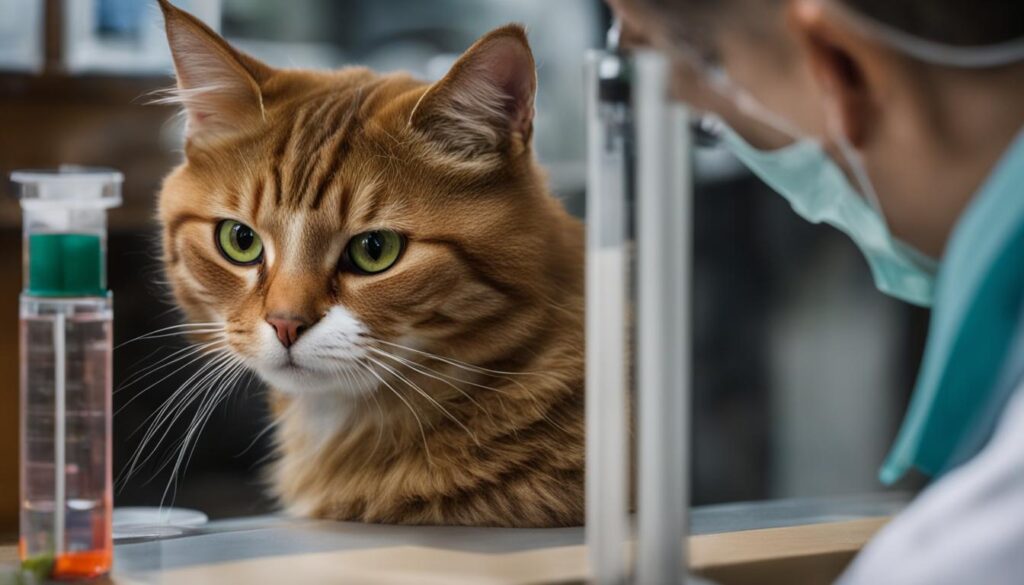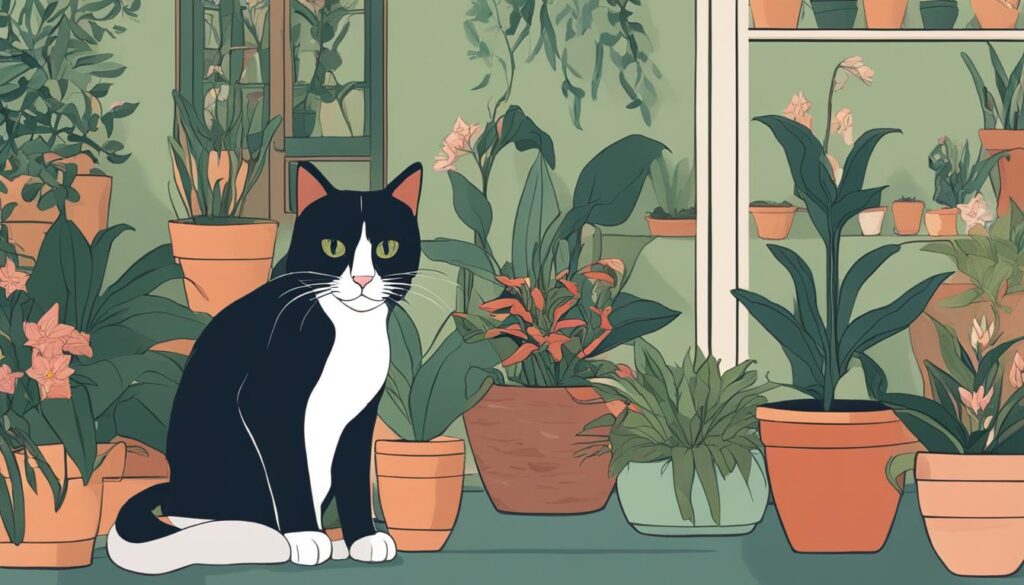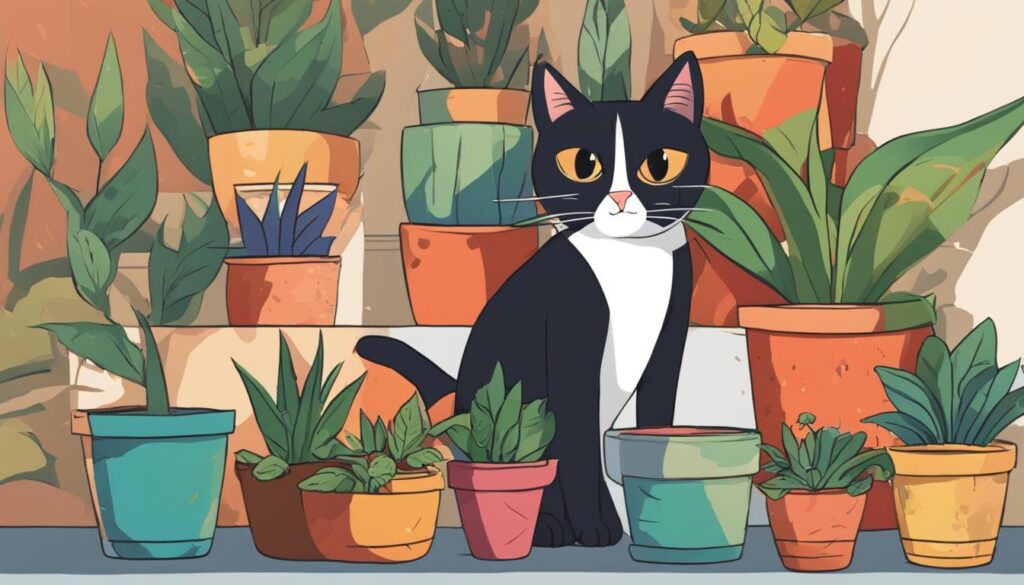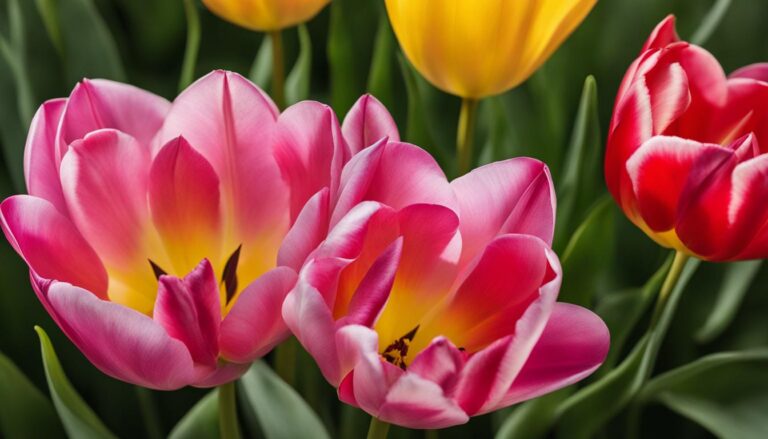Les tulipes sont-elles toxiques pour les chats ?? En tant que propriétaire d'un chat, il est important d'être conscient des dangers potentiels qui peuvent nuire à votre ami à fourrure. Les tulipes, bien que belles et vibrantes, peuvent constituer une menace pour la santé de votre chat. Dans ce guide, nous allons explorer les dangers des tulipes. empoisonnement des chats par les tulipes et fournissent de précieux conseils pour protéger votre compagnon félin des plantes toxiques.
Principaux enseignements :
- Les tulipes sont toxiques pour les chats, chaque partie de la plante contenant des composés nocifs.
- La consommation d'une grande quantité de tulipes ou le fait de manger le bulbe peut entraîner une urgence médicale.
- Identifiez et évitez les tulipes pour assurer la sécurité de votre chat.
- Choisir plantes adaptées aux chats comme les orchidées, les tournesols et les roses.
- Consultez un vétérinaire si vous pensez que votre chat a ingéré des tulipes ou qu'il présente des symptômes d'empoisonnement aux tulipes.
Identifier et éviter les tulipes
Les tulipes sont facilement identifiables par leur forme distinctive et leurs fleurs éclatantes. Ces fleurs se déclinent souvent en différentes nuances de rouge, de rose, de jaune et de violet, ce qui en fait un choix populaire pour les jardins et les compositions florales. Cependant, lorsqu'il s'agit de la sécurité de vos compagnons félins, il est essentiel d'éviter les tulipes. Les chats sont des créatures curieuses et leur nature exploratrice peut les amener à grignoter ces plantes toxiques, ce qui constitue une menace potentielle pour leur santé.
En tant que propriétaire responsable d'animaux domestiques, il est essentiel d'être vigilant et d'identifier et d'éviter les tulipes dans votre maison et votre jardin. Les feuilles des tulipes sont longues, minces et généralement de couleur verte. Elles poussent à partir d'une tige centrale qui porte au sommet la fleur emblématique de la tulipe. Les fleurs ont une forme de coupe et peuvent avoir une seule couche de pétales ou plusieurs couches, créant une apparence luxuriante et voyante. En vous familiarisant avec les caractéristiques des tulipes, vous pourrez facilement les distinguer des autres plantes non toxiques.
Pour garantir la sécurité de vos amis félins bien-aimés, il est préférable de ne pas introduire de tulipes dans votre maison ou de les planter dans votre jardin. Optez plutôt pour des plantes adaptées aux chats qui ajouteront de la beauté à votre espace sans présenter de risque pour vos animaux de compagnie. Les orchidées, les tournesols, les roses, les mufliers, les zinnia et les crocus de printemps sont des alternatives aux tulipes qui conviennent aux chats. Ces plantes n'offrent pas seulement un spectacle visuel époustouflant, mais aussi la tranquillité d'esprit de savoir qu'elles sont sans danger pour vos compagnons à poils.
Identifier et éviter les tulipes
Tableau : Comparaison entre les tulipes et les Plantes adaptées aux chats
| Tulipes | Plantes adaptées aux chats |
|---|---|
| Contient des composés toxiques | Sans danger pour les chats |
| Feuilles longues et minces | Formes variées des feuilles |
| Fleurs distinctives en forme de coupe | Diverses formes et couleurs de fleurs |
| Plusieurs couches de pétales | Une ou plusieurs couches de pétales |
En faisant attention aux plantes qui entourent votre chat, vous pouvez créer un environnement accueillant pour les chats, à la fois attrayant et sûr. N'oubliez pas que la prévention est essentielle et qu'un petit effort supplémentaire dans le choix des plantes peut contribuer grandement à assurer le bien-être de vos compagnons à poils.
Effets de l'empoisonnement par les tulipes chez les chats
Les tulipes ne sont pas seulement de belles fleurs, elles contiennent également des composés toxiques qui peuvent être nocifs pour les chats. Lorsque les chats ingèrent des tulipes, ils peuvent présenter une série de symptômes indiquant un empoisonnement par les tulipes. Il est essentiel que les propriétaires de chats soient conscients de ces symptômes et prennent des mesures immédiates s'ils pensent que leur ami félin a ingéré des tulipes.
Les symptômes de toxicité de la tulipe chez les chats peut varier en fonction de la quantité de tulipe ingérée et de la sensibilité de chaque chat. Les symptômes les plus courants sont la bave, les nausées, les vomissements, la diarrhée, l'accélération du rythme cardiaque et les problèmes respiratoires. Ces symptômes peuvent se manifester quelques heures après l'ingestion de tulipe et peuvent aller de légers à graves.
Dans les cas graves, lorsqu'un chat a consommé une grande quantité de tulipes, des symptômes plus sérieux peuvent apparaître, tels que des convulsions, le coma ou même la mort. Il est essentiel de consulter un vétérinaire si votre chat présente l'un de ces symptômes graves ou si vous pensez qu'il a ingéré des tulipes.
Tableau : Symptômes de la toxicité des tulipes chez les chats
| Symptôme | Description |
|---|---|
| Bave | Salivation excessive ou bave |
| Nausées | Sensation de nausée ou d'inconfort gastrique |
| Vomissements | Expulsion forcée du contenu de l'estomac |
| Diarrhée | Selles molles ou aqueuses |
| Augmentation du rythme cardiaque | Pouls ou rythme cardiaque élevé |
| Problèmes respiratoires | Difficulté à respirer ou respiration superficielle |
| Crises d'épilepsie | Spasmes musculaires incontrôlés ou convulsions |
| Coma | État d'inconscience et de non-réponse |
| La mort | Pertes en vies humaines |
Si vous pensez que votre chat a ingéré des tulipes ou qu'il présente des symptômes d'empoisonnement, il est important de consulter un vétérinaire dès que possible. Votre vétérinaire sera en mesure d'évaluer l'état de votre chat et de lui administrer le traitement nécessaire. N'essayez pas de faire vomir votre chat ou de lui administrer des médicaments sans l'aide d'un professionnel.
Rappelez-vous qu'il vaut toujours mieux prévenir que guérir. Gardez les tulipes et autres plantes toxiques hors de portée de votre chat pour assurer sa sécurité. Optez plutôt pour des plantes adaptées aux chats et créez un environnement respectueux des animaux de compagnie dans votre maison. En prenant ces précautions et en restant vigilant, vous pouvez protéger votre compagnon félin bien-aimé des dangers de la toxicité des tulipes.
Traiter l'empoisonnement par les tulipes chez les chats
Si vous pensez que votre chat a ingéré des tulipes ou qu'il présente des symptômes d'empoisonnement, il est important de prendre des mesures immédiates. Même si les cas bénins ne nécessitent pas de traitement immédiat, il est toujours préférable de pécher par excès de prudence et de demander conseil à un vétérinaire ou à un service d'assistance téléphonique pour les intoxications animales. Une intervention précoce peut considérablement améliorer les chances d'une issue positive pour votre animal bien-aimé.
Si votre chat n'a mâchouillé qu'une partie de la tulipe et qu'il ne présente pas de symptômes graves, vous pouvez commencer par demander conseil à votre vétérinaire habituel. Il pourra vous recommander de surveiller attentivement votre chat pour déceler tout changement dans son état ou son comportement. Toutefois, il est essentiel de ne pas tarder à consulter un professionnel si les symptômes de votre chat s'aggravent ou s'il a ingéré une grande quantité de tulipes.
Le traitement de empoisonnement des chats par les tulipes dépend de la gravité des symptômes. Les cas bénins peuvent ne nécessiter que des soins de soutien, tels que des médicaments anti-nauséeux, pour aider à soulager l'inconfort. Toutefois, dans les cas plus graves, votre vétérinaire peut être amené à administrer des traitements tels que des fluides intraveineux, du charbon actif pour absorber les toxines, ou d'autres thérapies de soutien pour gérer les symptômes et prévenir d'autres complications.
| Symptômes de l'empoisonnement par les tulipes chez les chats | Options de traitement |
|---|---|
| - Bave | - Soins de soutien |
| - Nausées et vomissements | - Médicaments anti-nausée |
| - Diarrhée | - Liquides intraveineux |
| - Augmentation du rythme cardiaque | - Charbon actif |
| - Problèmes respiratoires | - Autres thérapies de soutien |
N'oubliez pas de toujours consulter un professionnel pour déterminer le meilleur plan d'action pour votre chat. Il sera en mesure d'évaluer la gravité de l'état de votre chat et de vous fournir des conseils et des options de traitement sur mesure. Votre réaction rapide et son expertise peuvent faire une différence significative dans le rétablissement de votre chat.

Protéger les chats des plantes toxiques
Pour assurer la sécurité de vos amis félins bien-aimés, il est essentiel de connaître les éléments suivants plantes communes toxiques pour les chats. Si les tulipes présentent un risque important, ce ne sont pas les seules plantes qui peuvent être nocives pour vos compagnons à poils. En vous familiarisant avec ces plantes et en prenant les précautions nécessaires, vous pouvez créer un environnement sûr pour votre chat.
Voici une liste de plantes communes toxiques pour les chats:
- Les lys : Ces magnifiques fleurs sont très toxiques pour les chats, en particulier les vrais lys tels que les lys de Pâques, les lys tigrés et les lys asiatiques.
- Les jacinthes : Ces fleurs printanières parfumées contiennent des toxines qui peuvent causer de graves problèmes de santé si elles sont ingérées par les chats.
- L'aloe vera : Bien qu'il s'agisse d'une plante domestique populaire connue pour ses propriétés curatives, l'aloe vera peut être toxique pour les chats s'ils en consomment.
- La marijuana : Le cannabis étant de plus en plus répandu, il est essentiel de le garder hors de portée de vos chats, car il peut avoir des effets néfastes sur leur santé.
Ce ne sont là que quelques exemples, et il existe de nombreuses autres plantes qui peuvent présenter un risque pour les chats. Il est important de rechercher et d'identifier toutes les plantes dont vous n'êtes pas sûr avant de les introduire dans votre maison ou votre jardin.
Créer un environnement favorable aux chats
Pour protéger votre chat des plantes toxiques, envisagez de mettre en œuvre les mesures suivantes :
- Retirez toutes les plantes toxiques de votre maison et de votre jardin et remplacez-les par des plantes adaptées aux chats. Optez pour des plantes comme l'herbe à chat, les plantes araignées ou les fougères de Boston, qui ne présentent aucun danger pour les chats.
- Gardez votre chat à l'intérieur ou donnez-lui un enclos extérieur sécurisé pour éviter qu'il n'entre en contact avec les plantes toxiques de votre quartier.
- Inspectez régulièrement vos espaces intérieurs et extérieurs pour détecter toute plante potentiellement nuisible et retirez-la immédiatement.
- Veillez à ce que votre chat ait de nombreuses possibilités de stimulation mentale et physique afin de le dissuader d'explorer les plantes par ennui ou par curiosité.
En prenant ces mesures proactives, vous pouvez créer un environnement favorable aux chats qui minimise le risque d'empoisonnement par les plantes et permet à votre ami à fourrure de rester en sécurité et heureux.

| Plante | Niveau de toxicité | Symptômes |
|---|---|---|
| Lys | Haut | Vomissements, insuffisance rénale |
| Jacinthes | Modéré | Vomissements, diarrhée |
| Aloe vera | Faible | Diarrhée, vomissements |
| Marijuana | Haut | Dépression, ataxie |
Quand consulter un vétérinaire ?
Si vous pensez que votre chat a ingéré des tulipes ou qu'il présente des symptômes d'empoisonnement, il est important de consulter rapidement un vétérinaire. Les composés toxiques présents dans les tulipes peuvent avoir des effets graves sur la santé de votre chat, et une intervention précoce est cruciale pour obtenir le meilleur résultat possible.
Quelques exemples courants symptômes de l'empoisonnement par les tulipes chez les chats Les symptômes les plus courants sont la bave, les nausées, les vomissements, la diarrhée, l'accélération du rythme cardiaque et les problèmes respiratoires. Si vous remarquez l'un de ces signes, il est essentiel de contacter votre vétérinaire habituel, le Pet Poison Helpline ou l'ASPCA Animal Poison Control pour savoir si votre chat a besoin d'une attention médicale immédiate ou si un traitement à domicile est suffisant.
Même si votre chat n'a mâchouillé qu'une partie d'une plante de tulipe et qu'il ne présente pas de symptômes graves, il est conseillé de consulter un professionnel pour s'assurer de son bien-être. Les vétérinaires peuvent fournir les soins et les conseils nécessaires pour résoudre tout problème potentiel et aider votre chat à se remettre d'un empoisonnement à la tulipe.
Comprendre le comportement des chats et l'exploration des plantes
Les chats sont connus pour leur nature curieuse, et cela inclut l'exploration des plantes de votre maison et de votre jardin. Cependant, il est important de comprendre leur comportement lorsqu'il s'agit d'explorer les plantes afin d'assurer leur sécurité. L'un des comportements les plus courants est de mâcher ou de grignoter les plantes, ce qui peut être le signe d'un problème de santé. le pica chez les chats.
Le pica est un état dans lequel les chats ont un besoin anormal d'aliments non alimentaires, tels que les plantes. Ce comportement peut résulter de carences nutritionnelles ou d'un inconfort gastro-intestinal. Si vous remarquez que votre chat s'intéresse fréquemment à des objets non alimentaires, il est recommandé de consulter un vétérinaire afin d'écarter tout problème de santé sous-jacent.
Pour que la curiosité de votre chat puisse s'exprimer en toute sécurité, envisagez d'intégrer les éléments suivants plantes d'intérieur adaptées aux chats dans votre maison. Ces plantes ne sont pas toxiques et peuvent être explorées en toute sécurité par votre ami félin. Quelques exemples de plantes d'intérieur adaptées aux chats comprennent l'herbe à chat, les plantes araignées et les fougères de Boston. Ces plantes n'ajoutent pas seulement de la verdure à votre maison, mais stimulent également votre chat.
Avantages des plantes d'intérieur adaptées aux chats
- Permet à votre chat d'explorer en toute sécurité
- Stimuler les sens de votre chat
- Encourager les comportements naturels
- Ajoutez de la verdure à votre maison
En introduisant plantes d'intérieur adaptées aux chatsAvec les tulipes, vous pouvez détourner la curiosité de votre chat des plantes potentiellement nocives comme les tulipes. Il est important de fournir à votre chat une variété de plantes sûres qu'il pourra explorer et apprécier. N'oubliez pas de toujours surveiller votre chat lorsque vous lui présentez de nouvelles plantes et retirez toutes les plantes susceptibles de provoquer des réactions allergiques ou des problèmes gastro-intestinaux.
| Plante | Niveau de toxicité |
|---|---|
| Herbe à chat | Non toxique |
| Plante araignée | Non toxique |
| Fougère de Boston | Non toxique |
N'oubliez pas qu'il est essentiel pour le bien-être de votre chat de comprendre son comportement et de lui offrir un environnement sûr. En incorporant des plantes d'intérieur adaptées aux chats et en surveillant leur exploration des plantes, vous pouvez vous assurer que votre chat reste heureux et en bonne santé.

Conclusion
Les tulipes sont toxiques pour les chats, il est donc important de les tenir à l'écart de vos amis félins pour assurer leur sécurité. Chaque partie de la tulipe contient des composés nocifs qui peuvent entraîner des urgences médicales s'ils sont ingérés en grandes quantités ou si le bulbe est mangé. Pour créer un environnement sûr pour vos animaux de compagnie, il est essentiel de savoir identifier les tulipes et d'éviter de les introduire dans votre maison ou de les planter dans votre jardin.
Heureusement, il existe de nombreuses plantes adaptées aux chats que vous pouvez utiliser à la place. Les orchidées, les tournesols, les roses, les mufliers, les zinnia et les crocus de printemps sont d'excellentes alternatives qui ne présentent aucun risque pour la santé de votre chat. En choisissant ces plantes plus sûres et en faisant attention aux plantes qui se trouvent à proximité de votre chat, vous pouvez contribuer à prévenir tout risque potentiel.
Si vous pensez que votre chat a ingéré des tulipes ou qu'il présente des symptômes d'empoisonnement aux tulipes, il est important de consulter immédiatement un vétérinaire. Contactez votre vétérinaire habituel, le Pet Poison Helpline ou l'ASPCA Animal Poison Control pour savoir si votre chat doit être examiné par un vétérinaire ou si un traitement à domicile est suffisant. N'oubliez pas que la prévention est essentielle pour assurer le bien-être de vos animaux de compagnie bien-aimés.




